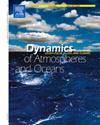A 2D numerical study on Kuroshio currents with free slip coastal boundary
IF 2
4区 地球科学
Q2 GEOCHEMISTRY & GEOPHYSICS
引用次数: 0
Abstract
The paper presents a comprehensive analysis of generating a Kuroshio current-like phenomenon using a novel mathematical model and advanced numerical methods. It helps to understand the streamline behavior on the western boundary over the time scales due to the presence of free slip conditions at the north and at the south coastal boundaries.
The ocean is modeled as a square domain occupied by homogeneous, incompressible fluid of constant density and a variable surface height. Dynamics of the flow are examined in a shallow water system. The salient parameters investigated here are the wind stress coefficient, the stochastic wind force coefficient, and time scales.
It is proved that streamlines are crowded on the western boundary through numerical study, and also these are bifurcated when the wind stress coefficient is 3.12. The bifurcation of the flow indicates the stability. It is also reported that the Milstein method and a standard numerical method are in good agreement while the Fokker–Planck equation-based method and the Milstein method are partially agreed. The solution by the Milstein method diverged while the solution by the Fokker–Planck method converged when .

具有自由滑动海岸边界的黑潮二维数值研究
本文采用新颖的数学模型和先进的数值方法对黑潮现象的产生进行了全面的分析。由于南北海岸边界存在自由滑移条件,有助于理解西边界在时间尺度上的流线行为。海洋被模拟成一个由密度恒定、表面高度可变的均匀、不可压缩流体所占据的方形区域。在浅水系统中研究了水流动力学。这里研究的主要参数是风应力系数、随机风力系数和时间尺度。数值研究表明,当风应力系数为3.12时,西边界流线拥挤,且流线分叉。流的分岔表示稳定性。Milstein方法与标准数值方法的一致性较好,而基于Fokker-Planck方程的方法与Milstein方法的一致性较好。当ω≥0.2时,Milstein法解发散,Fokker-Planck法解收敛。
本文章由计算机程序翻译,如有差异,请以英文原文为准。
求助全文
约1分钟内获得全文
求助全文
来源期刊

Dynamics of Atmospheres and Oceans
地学-地球化学与地球物理
CiteScore
3.10
自引率
5.90%
发文量
43
审稿时长
>12 weeks
期刊介绍:
Dynamics of Atmospheres and Oceans is an international journal for research related to the dynamical and physical processes governing atmospheres, oceans and climate.
Authors are invited to submit articles, short contributions or scholarly reviews in the following areas:
•Dynamic meteorology
•Physical oceanography
•Geophysical fluid dynamics
•Climate variability and climate change
•Atmosphere-ocean-biosphere-cryosphere interactions
•Prediction and predictability
•Scale interactions
Papers of theoretical, computational, experimental and observational investigations are invited, particularly those that explore the fundamental nature - or bring together the interdisciplinary and multidisciplinary aspects - of dynamical and physical processes at all scales. Papers that explore air-sea interactions and the coupling between atmospheres, oceans, and other components of the climate system are particularly welcome.
 求助内容:
求助内容: 应助结果提醒方式:
应助结果提醒方式:


